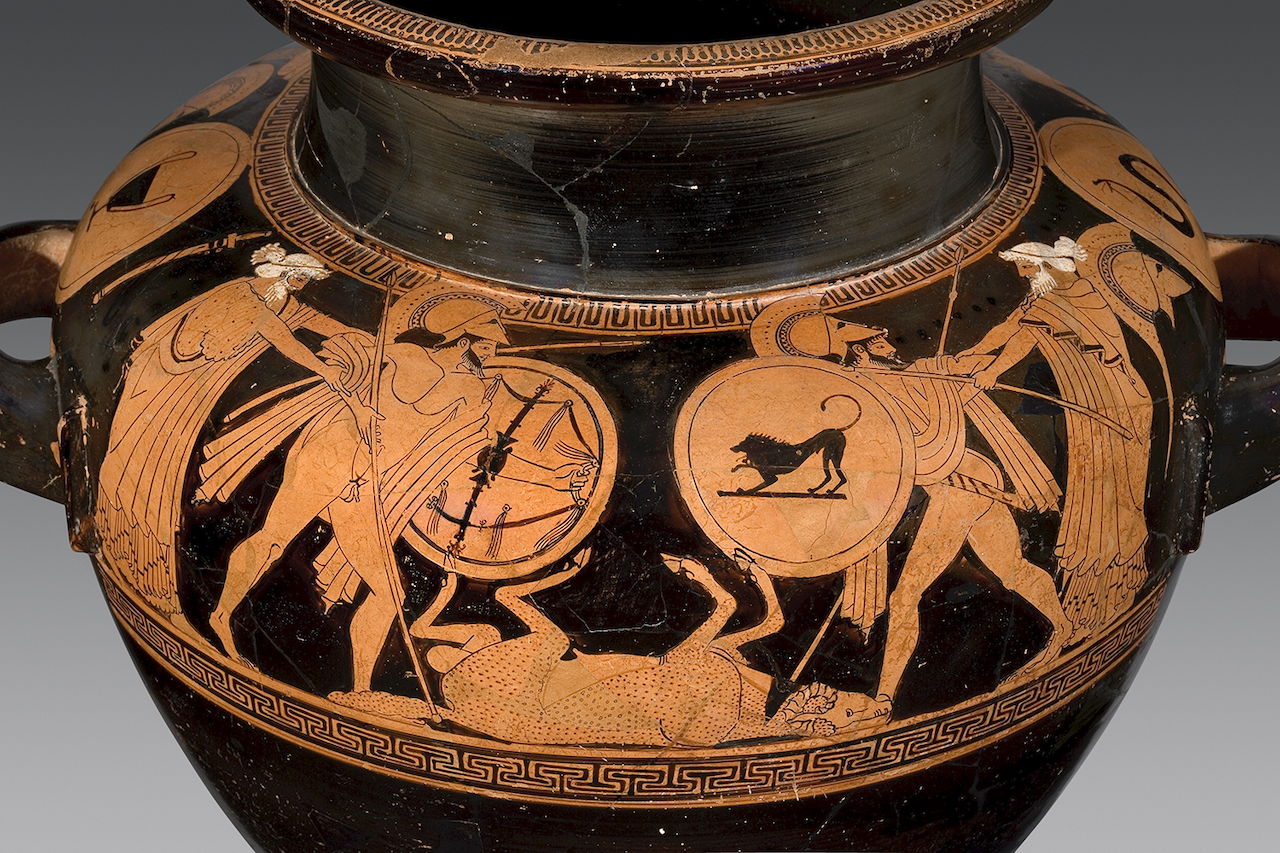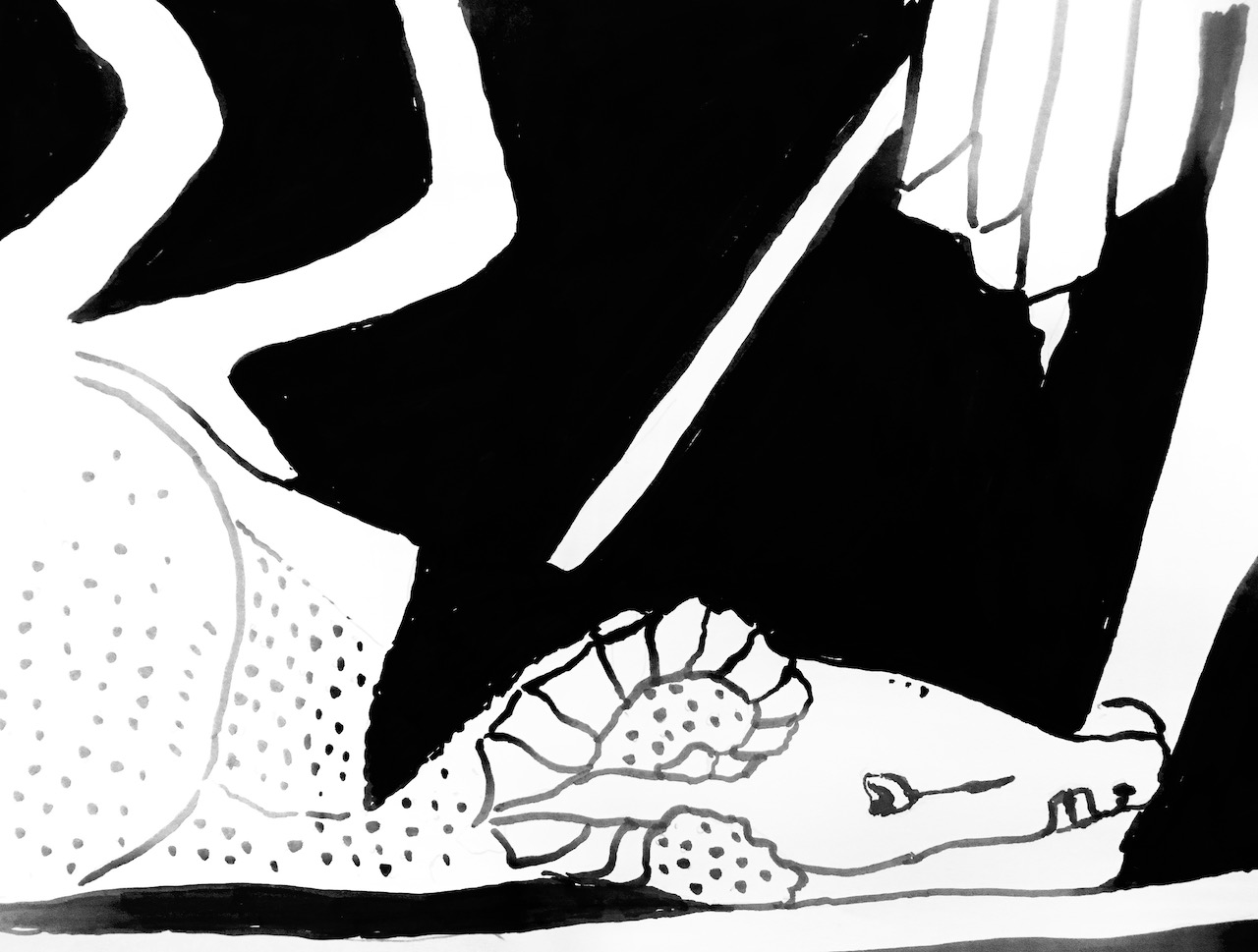2020.08.21 | By Gregory Nagy
§0. I show here a picture of a ram being sacrificed. His throat is being slit. This picture, a close-up of a painting on a fragmentary vase now housed at the Getty Museum in Malibu, was noted by Gloria Ferrari Pinney in a brief essay that she wrote in response to an essay of mine. Both essays are posted in Classical Inquiries 2020.07.31. My new essay here is an extension of my earlier essay, which concerned another picture of a sacrificial ram. In this new essay, I hope to correlate the meanings of the two pictures.

§1. In her essay, Pinney makes some essential observations about the painting on the Malibu vase. She concentrates on “two superimposed figural bands.” Pictured in the upper band is the sacrificing of the ram and, next to that scene, to our right, there is a scene of combat between a pair of warriors; then, in the lower band, we see the corpse of Patroklos being delivered to a grieving Achilles.
§2. In her reference to the slitting of the ram’s throat, Pinney mentions the classical Greek word sphágia ‘animal sacrifice’, following the analysis of Michael Jameson (2014:139–141), who interprets this picture painted on the Malibu vase as a reference to a custom, not attested in Homeric poetry, where warriors sacrifice a ram on the field of battle before the beginning of combat. Jameson goes on to say (pp. 140–141) that the ram that is being killed in this painting “would in any case have been taken to be a victim sacrificed for success in the battle taking place to the right, whatever the ultimate fate of the animal’s body.”
§3. I have two initial reservations about this formulation. First, with reference to the battle that is taking place to our right in this picture, I note that the focus is on a one-on-one fight between two combatants. Second, following an observation made by Pinney, I note that the fighting here is analogous to what we see being pictured in a painting on a vase housed in Basel. I analyzed that painting in the previous post, and I show a picture of it once again here:

§4. We see in the Basel picture a dead ram, with his throat slit wide open, who is being fought over by two contending warriors, to be identified as the heroes Hector and Ajax, fighting on opposing sides in the Trojan War as champions respectively of the Trojans and the Achaeans. But the question is, what is the fighting about? That is to say, what is really at stake here? For me, as I argued in my previous essay, the fighting is all about the possession of the dead body of the hero Patroklos, who has just been killed by Hector, and the picturing of a dead ram instead of the dead hero needs to be explained as a way of representing the role of Patroklos as a ritual substitute of Achilles. For my friend Gloria Pinney, on the other hand, whatever connection there may be between the dead ram and Patroklos is more complicated. In her essay written in response to mine, Pinney draws our attention to another vase painting that depicts the sacrifice of a ram: it is the picture painted on the Malibu vase, showing the moment when the ram’s throat is being slit, and we see here also some other details that are comparable with details depicted in the picture of the dead ram painted on the Basel vase.
§5. After comparing these details, Pinney goes on to say: “What gives me pause is the interpretation of the slaughtered ram [pictured on the Basel vase] as the metaphoric substitute for the corpse of Patroclus.” She adds: “In my experience, the imagery of the vases is not so straightforwardly poetic, in fact I can think of no other instance.”
§6. In the essay I present here, I offer a clarification. I think that the idea of substituting a sacrificial ram for Patroklos is not a matter of poetry. In other words, the picturing of a sacrificed ram is not so much a matter of myth as mediated by the verbal art of poets. Rather, it is more a matter of ritual as mediated by the visual art of painters.
§7. In the picture painted on the Basel vase, the identities of the two combatants is clear: they are Hector and Ajax. And, at least in terms of my interpretation as I presented it in the previous essay, the stakes are high, since the fight between Hector and Ajax, if we compare it to the fight between these same two heroes in Iliad 17, is all about the possession of the dead body of Patroklos. Not only in the verbal art of Homeric poetry, as in Iliad 17, but also in the visual art of at least two extant vase paintings, one of which I showed in the previous essay, Hector and Ajax can be pictured as fighting over the corpse of Patroklos himself, not over a newly-sacrificed ram. By contrast, in the picture painted on the Basel vase, we do see a newly-sacrificed ram positioned precisely where other pictures show instead the corpse of Patroklos. That is why I see a substitution here. But I view the substitution of the newly-sacrificed ram for Patroklos in the painting on the Basel vase to be an idea grounded primarily in the rituals of hero cult and only secondarily in the poetics of myths that tell about the lives and times of heroes worshipped in hero cult. Such myths connect directly to rituals involved in the cults of heroes like Patroklos, and a premier form of these rituals, as I pointed out in the previous essay, is the sacrificing of rams to the cult heroes.
§8. In terms of my argumentation, then, I cannot accept the idea, considered above at §2, that the combatants pictured on the Malibu vase, who are seen fighting one-on-one to the right of the scene showing the sacrifice of a ram, are concerned only about success in the battle taking place and are indifferent to “the ultimate fate of the animal’s body.”
§9. A problem remains. As Pinney points out, there is a painting, housed in Würzburg (L 508), that shows the old men Phoenix and Priam acting as restrainers of Ajax and Hector respectively, and we see here an analogy with what happens in Iliad 7—even though the restrainers of the two warriors there are two heralds, not the two old men. The analogy is made clear by the fact that there is a reference in the Würzburg painting to an exchange of gifts that happens after Ajax and Hector fight to a draw. Such a reference in the Würzburg painting makes the scene analogous only to the events of Iliad 7, not to the events of Iliad 17, where Ajax succeeds in rescuing the body of Patroklos from Hector—but without killing Hector. So, similarly, the Basel painting might possibly be referring to a fight between Ajax and Hector that is analogous to that other fight in Iliad 7 and not to the fight that the two of them have later, as narrated in Iliad 17, where they are contending over possession of the corpse of Patroklos. Still, I am not sure that the two old men who stand behind Ajax and Hector in the Basel painting are both restraining the two fighting warriors. Yes, Priam standing behind Hector does in fact seem to be restraining that warrior, but what about Phoenix standing behind the warrior Ajax? In this case, it seems to me, the old man could be encouraging Ajax to fight off Hector and thus to recover the corpse of Patroklos, bringing it back to the Achaeans side. And this idea of recovering the body of the hero conjures the idea of a sacrificial ram as a ritual substitute for the hero himself, just as Patroklos is a ritual substitute for the grieving Achilles, who will be presented with the corpse of his other self in the rest of the painting.
Bibliography
Griffiths, A. 1985. “Patroklos the Ram.” Bulletin of the Institute for Classical Studies 32:49–50.
Griffiths, A. 1989. “Patroklos the Ram (Again).” Bulletin of the Institute for Classical Studies 36:139.
H24H. See Nagy 2013.
Jameson, M. H. 2014. “The Ritual of the Athena Nike Parapet.” Cults and Rites in Ancient Greece: Essays on Religion and Society (ed. A. B. Stallsmith) 127–144. Cambridge; recast from Ritual, Finance, Politics: Democratic Accounts Presented to David Lewis (ed. R. Osborne and S. Hornblower) 307–324. Oxford.
Lowenstam, S. 1981. The Death of Patroklos: A Study in Typology. Beiträge zur Klassischen Philologie 133. Königstein/Ts.
Lowenstam, S. 1992. “The Uses of Vase Depictions in Homeric Studies.” Transactions of the American Philological Association 122:165–98.
Lowenstam, S. 1997. “Talking Vases: The Relationship between the Homeric Poems and Archaic Representations of Epic Myth.” Transactions of the American Philological Association 127:21–76.
Lowenstam, S. 2008. As Witnessed by Images: The Trojan War Tradition in Greek and Etruscan Art. Baltimore.
Muellner, L. 2012. “Grieving Achilles.” Homeric Contexts: Neoanalysis and the Interpretation of Oral Poetry, ed. F. Montanari, A. Rengakos, Ch. Tsagalis, 197–220. Trends in Classics Supplementary Volume 12. Berlin and Boston. http://nrs.harvard.edu/urn-3:hlnc.essay:MuellnerL.Grieving_Achilles.2012.
Nagy, G. 1976. “The Name of Achilles: Etymology and Epic.” In Studies in Greek, Italic, and Indo-European Linguistics Offered to Leonard R. Palmer, ed. A. M. Davies and W. Meid, 209–237. Innsbruck. Recast as ch. 5 and ch. 6 (= pp. 69–93 and 94–117) in Nagy 1979.
Nagy, G. 1979. The Best of the Achaeans: Concepts of the Hero in Archaic Greek Poetry. Rev. ed. 1999, with new introduction. Baltimore. http://nrs.harvard.edu/urn-3:hul.ebook:CHS_Nagy.Best_of_the_Achaeans.1999.
Nagy, G. 2009|2008. Homer the Classic. Printed | Online version. Hellenic Studies 36. Cambridge, MA, and Washington, DC. http://nrs.harvard.edu/urn-3:hul.ebook:CHS_Nagy.Homer_the_Classic.2008.
Nagy, G. 2012. “Signs of Hero Cult in Homeric Poetry.” In Homeric Contexts: Neoanalysis and the Interpretation of Homeric Poetry, ed. F. Montanari, A. Rengakos, and Ch. Tsagalis, 27–71. Trends in Classics Supplementary Volume 12. Berlin and Boston. http://nrs.harvard.edu/urn-3:hlnc.essay:Nagy.Signs_of_Hero_Cult_in_Homeric_Poetry.2012.
Nagy, G. 2013. The Ancient Greek Hero in 24 Hours. Cambridge, MA. http://nrs.harvard.edu/urn-3:hul.ebook:CHS_NagyG.The_Ancient_Greek_Hero_in_24_Hours.2013.
Sinos, D. S. 1980. Achilles, Patroklos, and the Meaning of Philos. Innsbrucker Beiträge zur Sprachwissenschaft 29. Innsbruck.
Tarenzi, V. 2005. “Patroclo ΘΕΡΑΠΩΝ.” Quaderni Urbinati di Cultura Classica 80:25–38.


